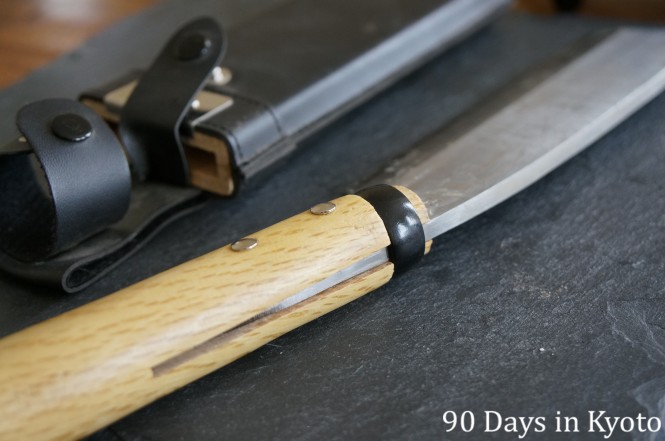One of the things that impressed me most during the first weeks in Japan was how my co-workers treated their tools. Every morning each gardener carried his or her heavy tool bags from our company’s garage and placed them carefully on the back of the truck. Garden tools, scissors, shears, knives, wood-working tools, heavy masonry and stone working tools. Levels, steel squares, strings. You name it. In the evening, after work when we waited for the last team to come back, everyone would clean their tools, sharpen them if necessary, repair them. Some built their own tools, or their own handles and grips for hammers, mallets, etc.
Often I was asked: Do you have a Nata? Do you have a bamboo saw? At first I had to reply “No”. Even if I owned them, there is no way I would have taken them on the plane since they are simply too heavy. Then someone would lend me his or her tool OR I was given another work. At that time I learned that in order to be trusted with a task, you need to have the right tools. Even if you are still learning, you need to have the tools in order to learn. Thankfully my senpai Laura, a lady from Lithuania who is very experienced in Japanese garden techniques, lent me her tools after she returned to Europe for the summer. From that moment on, I could say: Yes, I have a nata. Yes, I have a security belt to climb trees. Yes, I have mallet. Yes, I have a bamboo saw. And I was trusted with more and more work and was able to learn a lot more.
I bought my own nata after a while. It is my whole pride and joy: It is super-sharp and simply beautiful. Also dangerous, apparently, since I cut my thumb and index finger last week. I still need to get more working experience with this tool. These are my pin-up pictures 😉

両刃 can be pronounced Moroha or Ryouba and means double-edged blade. The 165 refers to the length of the blade, 16.5 cm

The inscription reads 鋼付 or hagane-tsuke. Hagane means steel, tsuke means to attach. See explanation in text below.
As you can see in the last picture, this nata is made using the Hagane-Tsuke (鋼付) technique. That means that mild steel (low carbon steel, relatively cheap and soft steel) is used for the body of the blade. The cutting edge however is made of steel, which makes it strong enough to withstand abrasion, yet easy enough to sharpen.
After using a nata it is best to clean the blade with a little bit of water and dry it with newsprint paper. Sharpen the blade only if needed. If you put away the nata for a longer period, use a soft cotton cloth to apply a thin coat of oil to the blade.



[…] this, the head gardener Jacob Kellner and I split bamboo to make bamboo slats. I used my new Nata (鉈), a square hatchet used by Japanese gardeners and fence builders. The bamboo I cut was very thick. […]
LikeLike
Interesting! The description of a daily full circle, from taking care with tools in the morning, through use, and finally maintaing with attention and putting back to rest until tomorrow, is so very much Japan as I know it. I also love how blades are attached. It’s art and functionality.
LikeLike
[…] (鉈), a slim hatchet, is the pride and joy of many Japanese gardeners. I was so proud to finally own one […]
LikeLike